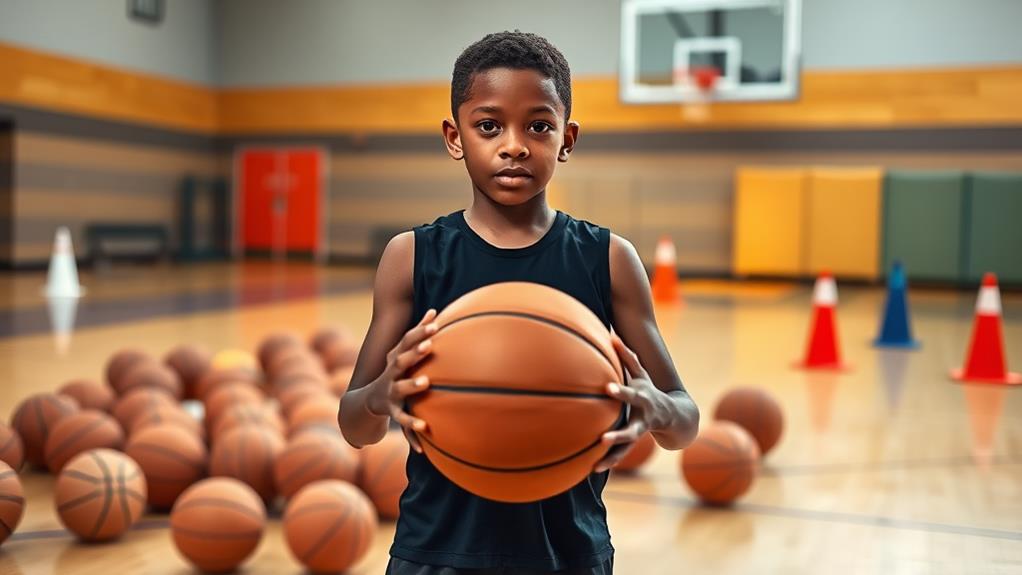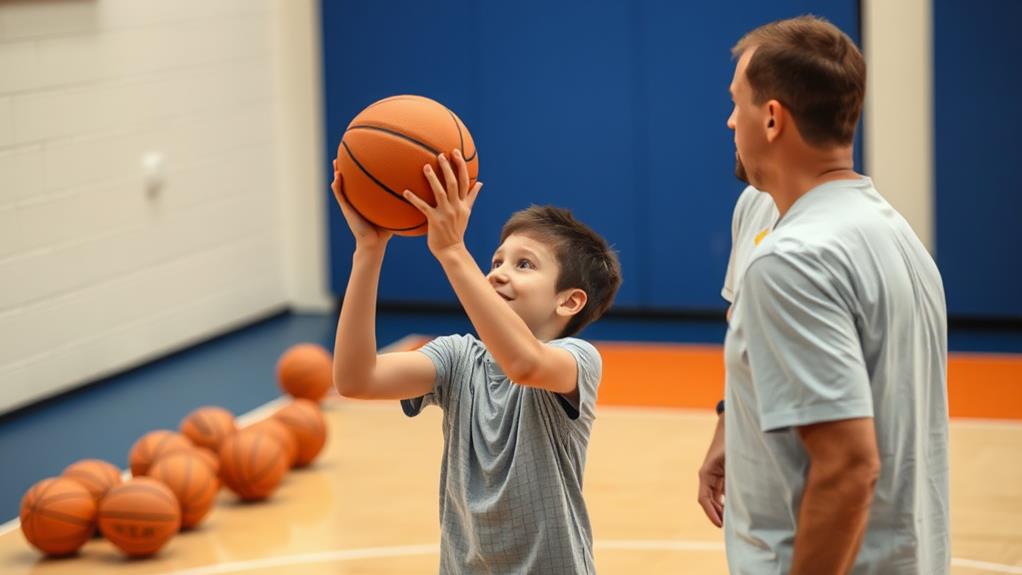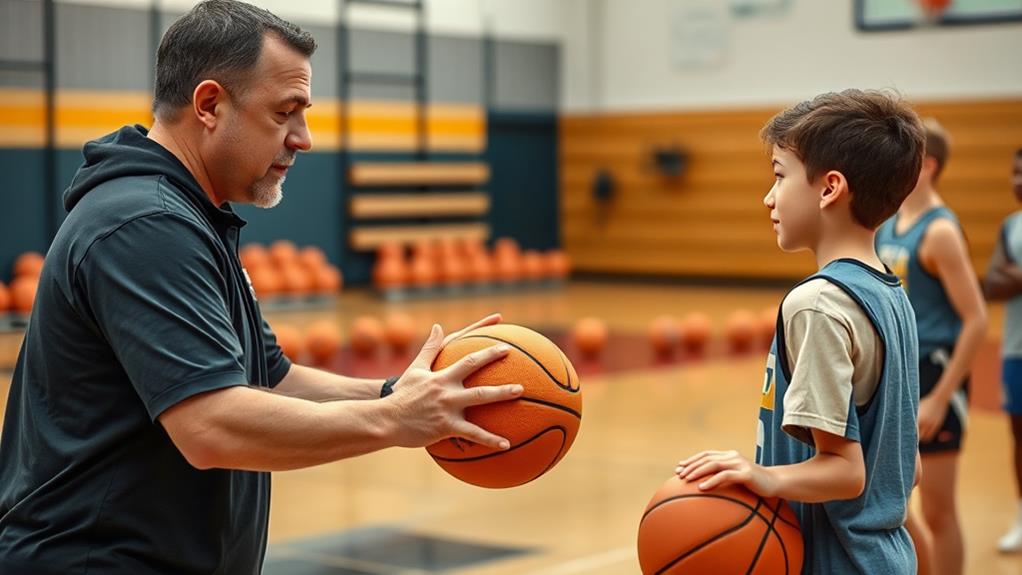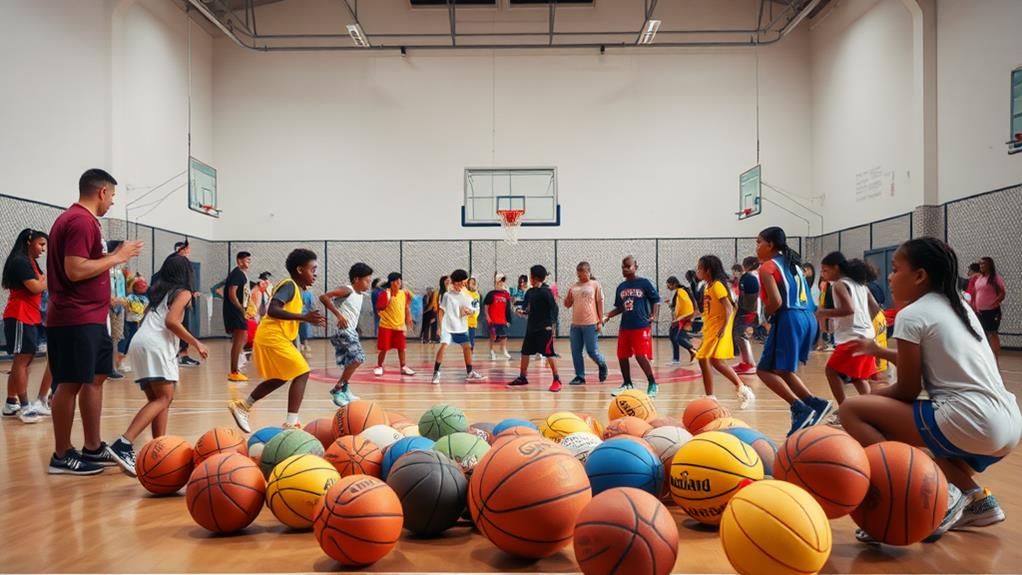
Choosing the Correct Youth Basketball Size for Training
October 13, 2024Choosing the right youth basketball size is vital for effective training and skill development. For ages 4-8, consider Size 3 or 4 to promote handling skills without strain. Size 5 suits players aged 9-11, while Size 6 is ideal for those 12-14. Players aged 14 and up should use Size 7 to prepare for advanced play. Using the correct size helps prevent poor shooting habits and boosts confidence. It also guarantees better grip and control, essential for mastering shooting techniques. If you're curious about how proper sizing impacts overall performance, there's much more to explore.
Importance of Correct Basketball Size
When it comes to youth basketball, using the right ball size is vital for both skill development and enjoyment of the game. Choosing the correct size allows young players to grip and control the ball effectively, which is significant for developing proper shooting and dribbling techniques.
Understanding the importance of building a full endurance team can further enhance a player's performance in practice and games. When kids use an incorrect size, it can lead to poor shooting habits that are tough to correct later on. In fact, studies show that 95% of players struggle to fix bad techniques formed during their early years.
It's important to take into account age-appropriate basketball sizes, like Size 5 (27.5 inches) for ages 9-11 and Size 6 (28.5 inches) for ages 12-14. These sizes guarantee that players can handle the ball without compromising their shooting form.
Additionally, the weight difference between sizes matters: a Size 7 ball (22 oz) is over twice as heavy as a Size 3 mini ball (10 oz), making it unsuitable for younger players who lack the strength.
Size Recommendations by Age
When picking the right basketball size for your child, it's vital to take into account their age and skill level.
Starting with a Size 3 for younger players helps them develop essential handling skills, while older kids benefit from larger sizes that match their growing abilities.
You can also explore cardio workouts that enhance their endurance for basketball.
Choosing the appropriate ball size not only supports skill development but also enhances their overall enjoyment of the game.
Age-Appropriate Ball Sizes
Selecting the right basketball size is essential for young players to enhance their skills and enjoyment of the game.
For children aged 4-8 years, a Size 3 basketball with a 22" circumference is ideal, fitting comfortably in their smaller hands and allowing them to build confidence. As players grow, those aged 5-8 should shift to a Size 4 basketball (25.5" circumference) to develop their skills effectively without the strain of larger balls.
When kids reach ages 9-11, a Size 5 basketball (27.5" circumference) becomes the best choice. This size balances weight and dimensions, promoting excellent skill development.
For boys aged 12-14 and girls aged 12 and up, a Size 6 basketball (28.5" circumference) reflects the official size used in women's leagues.
Skill Development Considerations
Choosing the right basketball size is vital for skill development as young players grow. For children aged 8 and below, a Size 4 basketball (25.5 inches) is recommended. This size matches their developing strength and skill levels, allowing them to practice effectively.
As players reach ages 9 to 11, using a Size 5 basketball (27.5 inches) helps facilitate skill progression and proper technique development.
Boys aged 12 to 13 should shift to a Size 6 basketball (28.5 inches) while girls aged 12 and up also use a Size 6 for competitive play. This guarantees that both boys and girls can develop skills required for higher levels of play.
When players reach age 14 and above, they should utilize a Size 7 basketball (29.5 inches), which prepares them for advanced competition and aligns with the official size used in men's leagues.
Using the right size basketball is fundamental. If young players use an inappropriate ball, they may develop poor shooting habits that are tough to correct later on.
Prioritizing the correct size at each stage of development supports effective skill growth for all youth players.
Impact on Shooting Technique

Using the right basketball size is essential for your shooting technique.
When you have a proper grip and the right weight, you can develop correct form and improve your accuracy.
The impact of analytics on player performance highlights how tailored training can enhance shooting skills.
Oversized balls can throw off your mechanics, making it harder to shoot effectively and potentially leading to bad habits.
Proper Grip Mechanics
Mastering proper grip mechanics is essential for enhancing your shooting technique in youth basketball. When you use the right ball size, you're able to comfortably wrap your hands around the ball, which promotes correct finger placement and hand alignment—key components of effective shooting form. Your shooting hand directs the force and aim of your shot, while your guide hand stabilizes the ball.
If you're using an oversized basketball, it can hinder your hand positioning, leading to poor shooting mechanics and bad habits that are tough to correct later on. Young players often struggle with their shooting technique, but by developing good grip mechanics early, you can set a strong foundation for your game.
A well-fitted ball enhances your control and grip, boosting your shooting accuracy and confidence during play.
Size and Weight Matters
The size and weight of a basketball play an essential role in shaping a young player's shooting technique. When young kids use a ball that's too large or heavy, they often compensate with improper form, leading to poor shooting techniques.
For instance, a standard men's size 7 basketball weighs 22 oz, considerably heavier than the 10 oz size 3 mini basketball. This size disparity can be intimidating for younger players, especially fourth graders around ages 9-10, who may struggle with a 28.5-inch basketball due to their insufficient strength.
Using the correct size and weight enhances grip and control, allowing you to focus on developing proper techniques. If you rely on a ball that doesn't suit your size or strength, you might inadvertently form bad shooting habits that are tough to correct later on.
Studies show that 95% of players with poor shooting habits due to incorrect ball size face challenges throughout their basketball journey. As a result, prioritizing age-appropriate equipment is vital.
With the right basketball, you can concentrate on your shooting form and set yourself up for long-term success on the court.
Developing Correct Form
Focusing on the right basketball size is vital for developing correct shooting form. When youth players use a size that's too big, like a size 7 ball, they often struggle with weight and grip. This can lead to improper hand positioning, which negatively impacts their shooting mechanics.
If you want your young athlete to master the game, using a properly sized basketball, such as a size 5 for ages 9-11, is essential.
Studies show that 95% of players who learn with the incorrect ball size face challenges in adjusting their shooting form later. By using the correct ball size, youth players can concentrate on grip and control, enabling them to develop better shooting techniques. This fosters a solid foundation for their skills, making it easier to improve as they grow.
Additionally, mastering shooting form with the right size ball can boost confidence in young athletes. When they feel comfortable with their equipment, they enjoy the learning experience much more.
Choosing the Right Material
Choosing the right material for a youth basketball is essential for enhancing a young player's experience on the court. When deciding, consider composite materials, which are often favored for their feel and grip. They mimic leather while being suitable for different playing conditions, making them perfect for indoor use.
If you're looking for something versatile, Mikasa rubber balls provide a great balance of durability and performance, especially for outdoor play. Additionally, understanding the impact of interactive match apps can help young players engage with the sport in innovative ways.
For players aged 5-8, size 4 basketballs are typically available in both composite and rubber materials. This variety allows you to cater to your child's preferences and needs. Keep in mind that the material you choose can greatly influence the ball's durability and grip. Composite balls usually outperform rubber ones on indoor surfaces, while rubber balls excel outside.
However, finding specific materials like size 4 balls in composite or leather may not always be easy, highlighting the need for more accessible options.
Coaches' and Parents' Role

Coaches and parents play a pivotal role in a young athlete's basketball journey, especially when it comes to selecting the right ball size. Coaches should take the time to educate parents about the importance of using age-appropriate basketball sizes, as understanding basic rules and structure of sports can prevent improper shooting techniques that may lead to long-term issues.
This can prevent improper shooting techniques that may lead to long-term issues. When parents actively participate in choosing the right basketball size, it greatly enhances their child's enjoyment and performance in the game.
Monitoring players' form while practicing with the correct-sized basketball allows coaches to provide immediate feedback and necessary adjustments. This fosters better skill development from an early age.
In addition, community support and resources, such as size charts and educational materials, can help parents grasp the importance of appropriate basketball sizes for youth players. This promotes a collective shift in perception regarding equipment needs.
Ultimately, both coaches and parents are critical in encouraging consistent practice with the right equipment. This consistency is essential for developing confidence and proper shooting form in young athletes, ensuring they grow into skilled players who love the game.
Alternative Game Formats
Finding the right size basketball is just one aspect of enhancing a young player's experience.
Another vital element is exploring alternative game formats that can greatly improve skill development and engagement. By implementing smaller team sizes, you can create an environment where participation flourishes, allowing each player to actively contribute to the game.
This approach not only fosters teamwork and respect among players of diverse backgrounds but also promotes inclusivity and unity, reflecting the values of enhanced cultural exchange.
Consider these benefits of alternative formats:
- Increased Ball Handling: 3-on-3 gameplay provides more opportunities for players to handle the ball and make decisions.
- Enhanced Skill Development: Smaller teams allow players to focus on fundamental skills without the pressure of a larger game.
- Greater Participation: Less crowded play encourages every player to get involved and take part in the action.
- Improved Engagement: These formats often lead to higher enjoyment levels, boosting players' confidence in a supportive setting.
Community Involvement in Youth Sports

Community involvement in youth sports plays an essential role in shaping the development and experience of young athletes. When you engage local organizations and basketball leagues, you can create a ripple effect of community support that shifts perceptions among parents about the importance of using age-appropriate basketball sizes.
Many parents may not realize how vital proper equipment is for their kids' skill development, as using the right tools can enhance their performance and overall enjoyment of the game. By offering insights into player statistics and performance analysis tools, you can help parents understand the impact of using the right ball size, ensuring young players have a consistent experience across various programs.
By organizing educational workshops, you help parents and coaches understand the impact of using the right ball size, ensuring young players have a consistent experience across various programs. Collaboration with schools, clubs, and community centers can promote awareness of correct basketball sizing. This awareness helps to foster a culture that prioritizes the needs of youth athletes.
You can also encourage community events, like skill development clinics, showcasing the benefits of appropriate basketball sizes. Utilizing reference charts at these events can clarify the significance of correct sizing, making it easier for parents to grasp how it contributes to their child's growth and success.
Together, we can build an understanding that empowers youth athletes through the right tools and community support.
Resources for Skill Development
When it comes to skill development in youth basketball, having access to the right resources can make all the difference.
Utilizing appropriate tools and programs can enhance your training sessions and help young players master their skills without risking injury. Understanding essential soccer equipment can also provide insight into the importance of proper gear in preventing injuries in any sport, including basketball.
Consider the following resources for effective skill development:
- RISE Youth Basketball Academy: Offers advanced and elite programs tailored for various age groups, ensuring kids get the right training according to their skill levels.
- Spring Holiday Camp: Scheduled for September 30, 2024, this camp provides a focused training session for young players to enhance their skills.
- Term 4 Skills Classes: Starting on October 19, 2024, these classes concentrate on fundamental basketball techniques, giving participants structured support.
- Size Charts and Recommendations: Utilizing age-appropriate basketball sizes, like a Size 5 ball for ages 9-11, can greatly improve skills and dampen the risk of injury.
Conclusion
In choosing the right basketball size for training, you're not just picking a ball; you're shaping your young athlete's future. It's amazing how a simple decision can enhance shooting technique and boost confidence. By involving coaches, parents, and the community, you create a supportive environment that fosters growth. So, as you make this choice, remember—it's not just about the game; it's about developing skills that last a lifetime. Your involvement today can spark greatness tomorrow!


